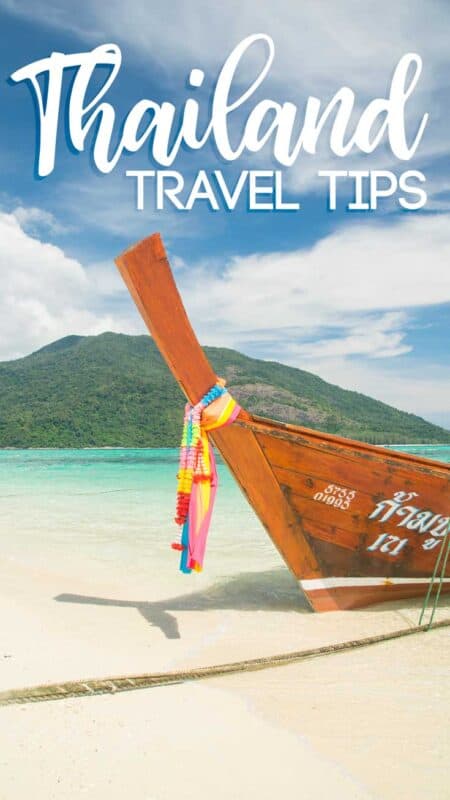Before jumping on that flight, there are a few must-know Thailand travel tips that will make your trip better and smoother!
There’s no other country we have spent more time in than Thailand. Over the past five years, we lived and traveled in Thailand for nearly two of those years.
It’s a place that is very special to us, and we want to help you plan the perfect trip to Thailand. We’ve learned a lot during our time in the country. Here are our top Thailand travel tips. Jump to information on:
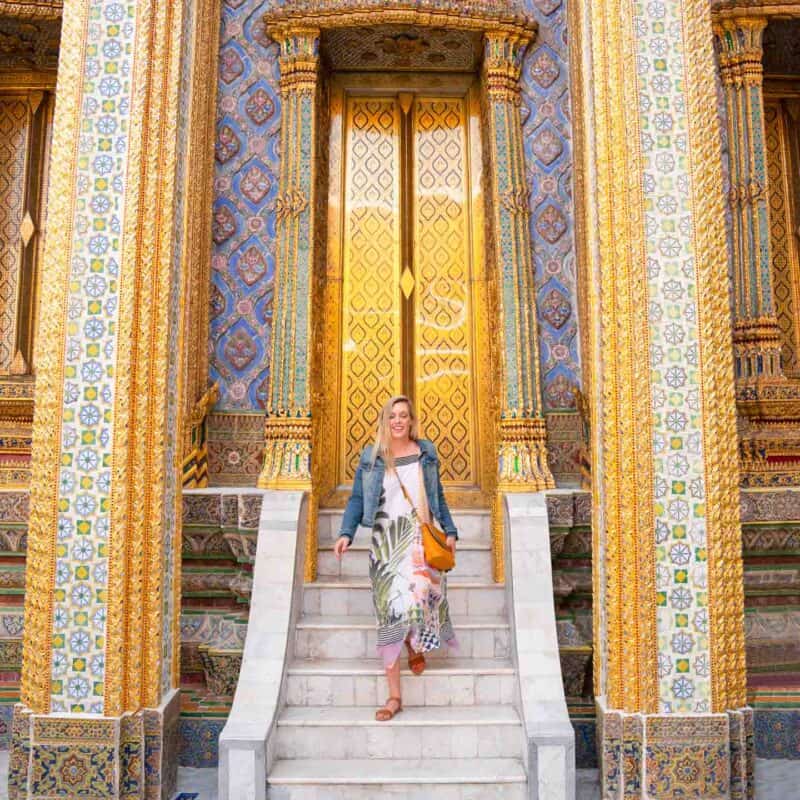
Things To Know About Thailand
Currency: Thai Baht
Best time to visit Thailand: November through April. The rainy season in Thailand is typically June-October. If you are island hopping to some of the best islands in Thailand, please note not all ferry routes will be operating during monsoon season.
During the rainy season, it doesn’t necessarily mean it will rain all day every day. We lived in Thailand during the rainy season, and it really wasn’t that bad. With like weather anywhere in the world, it’s very unpredictable.
Visa: FREE 30 days on arrival for most citizenships, click here to verify your nationality has a free visa on arrival.
What to wear in Thailand: The climate in Thailand is generally hot. Bring plenty of warm-weather clothes, but pack a lightweight jacket and a pair of jeans if you visit Northern Thailand during November-January. The nights can be surprisingly cool.
What Vaccinations are needed for Thailand: There are no necessary vaccinations needed to enter Thailand. However, if you are an avid traveler, it is always good to get the following vaccinations:
- Hepatitis A
- Hepatitis B
- Typhoid
- Yellow Fever (required for some of our safaris in Africa)
- Measles-mumps-rubella (MMR)
- Tetanus
- Polio vaccine
- Rabies (many people don’t have this, and it is hard to get; even if you get bit by a dog in Thailand and you have a rabies vaccination, you still have to go to the hospital and get rabies treatment.)
Wifi & Sim Cards: Free Wi-Fi is everywhere in Thailand, and getting a local data package on your phone is super cheap. The local company AIS, we think is the best SIM card in Thailand. Tourist packages are less than $10 for a week. It’s the easiest to get a SIM card in the Bangkok airport right after customs & immigration.
Electricity: 220 volts with Europe/Asia round prongs outlets. We recommend this US to Thailand Adapter -or- this universal travel power adapter (works worldwide)
Religion: Primarily Buddhist, shoulders and knees have to be covered when entering temples in Thailand. In the south of Thailand, there is a much stronger Muslim population, and it is common to see Thai women with headscarves and mosque callings. If you are visiting Bangkok, here are the top 10 temples in Bangkok.
Population of Thailand: 69 million
Getting Around Thailand
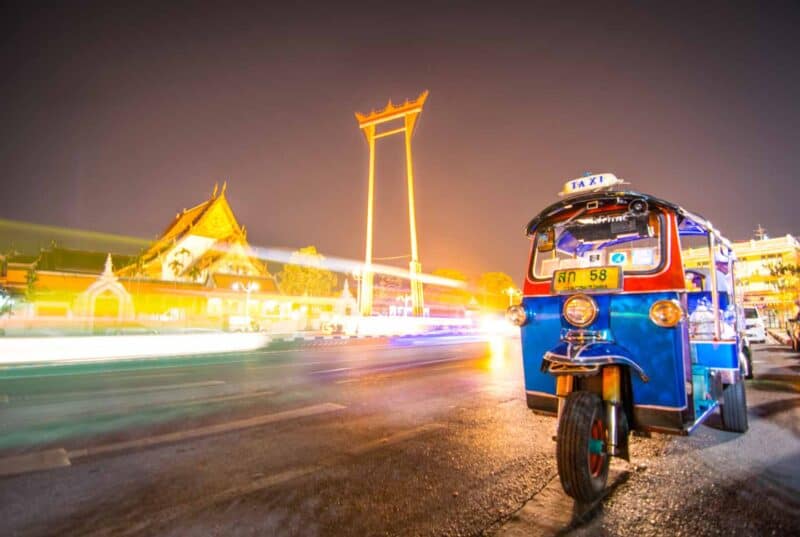
Domestic Flights Within Thailand: Flying between cities in Thailand is super affordable and the easiest way to see as many highlights as possible. For example, $15 to fly from Chiang Mai to Bangkok. Our personal favorite airlines are Air Asia, Thai Smile, and Thai Airways.
Air Asia is your standard budget airline, where you pay for checked bags, but in Asia, you pay based on how much weight you check. If you have a 50 lb (23kg) bag, purchase the 25kg option. If you fly Thai Smile or Thai Airways, bags are included for free, and they have the airline snack ever, the best green curry hot pocket.
Other cheap airlines in Thailand are Bangkok Airways, Thai Lion Air, Nok Air, and VietJetAir.com. We always use Skyscanner to find the best prices.
Uber in Thailand: One of the easiest ways to get around Bangkok is Uber, but the hardest thing is sometimes finding your Uber in Bangkok’s traffic. Sometimes, it can be challenging to explain to drivers where you want to go and then have the right change.
Uber makes it so easy by charging your credit card directly, and you put in your destination. Uber in Thailand is super cheap; when we lived in Chiang Mai, it was 40 baht (less than $1.25) to take a 20-minute Uber at 2 a.m.
TIP: Set your pickup location on side streets and not the main ones, as it can be impossible for them to pull over and you find them. We also suggest tipping the Uber drivers something, even if it’s only 10 baht ($0.30 USD).
Taxis: Taxis are way cheaper than the Western world. On average, you can sit in a taxi for an hour and spend maybe $10. Make sure to agree on either a set price or to run the meter. Sometimes, taxis will refresh to run the meter and want to agree on a price. We have always found the meter is a better deal. Traffic in Bangkok can be really bad, try and avoid taxis during rush hour.
Tuk Tuks: Tuk Tuks in Thailand are a blast and a common transport. Make sure to always negotiate the fare in advance. In some cities, there are very few taxis, and tuk tuks run the market. You’ll find this the case on islands. We suggest them for short trips from the Grand Palace to Wat Pho or similar.
Tuk Tuk scams are famous all around Thailand. Often Tuk Tuks will tell you they will give you a free ride in Bangkok, but they end up bringing you to a ton of shops, hoping you purchase something, so they get a kickback from the shops.
Ferries In Thailand: If seeing some of the best islands in Thailand on your bucket list, plan on taking a few ferry rides. The ferries vary in size based on where they are going to and from. Some are large ferry boats carrying hundreds of people, and others are smaller speedboats carrying less than 50 people.
The ferries don’t run all the routes year-round due to the monsoon season, which makes it more difficult to get to places during May-October. If you’re traveling during high season, it’s best to book your ferry tickets online here in advance to secure your seat. There are several packages that include bus, shuttle, and ferry all in one ticket.
Buses in Thailand: For those on a budget, traveling by bus in Thailand is cheap and easy. We always suggest comparing the cost of the bus vs. flying and deciding how much your time is worth. Check bus prices online here.
Several tourists prefer overnight buses as this saves them a night’s accommodation we, however, urge against this. Traveling on night buses in Thailand can be very dangerous. Every year, there are several fatal accidents. It’s just not worth it, in our opinion. We’ve heard of many people who had items stolen out of their bags that were under the bus at night. Make sure to have travel insurance for instances like this and get a police report.
Don’t forget your insurance! You never know when you’ll need it. We suggest getting travel insurance with Safety Wing. Which coverage includes medical, trip interruption, lost luggage, and more. Often rates are as low as $12 a week.
BTS/MRT in Bangkok: Bangkok has a really good subway, which is called the BTS Skytrain or MRT. Both systems connect to the Bangkok Airport Link, which goes right to and from BKK airport. You will need to purchase a separate airport link pass.
For both subway lines, you pay based on the distance you travel. You swipe in and out so it knows exactly what you should pay. You can purchase single tickets at each station (coins only), or if you know you’ll be riding a lot that day, buy a 140 baht ($4) unlimited day pass. The day pass is great not only to save you money but also to spend time waiting in line buying passes for each trip.
Train: Trains travel all across Thailand. There are several types of train classes and durations, so make sure to inquire when purchasing a ticket. Train travel is popular for budget travelers to save on accommodation.
For example, traveling by train from Bangkok to Chiang Mai will take 10+ hours and cost $20+. If you remember from above, you can purchase a flight for $16 and be there in 90 minutes. If you’re short on time, skip the train and fly to make the most of your trip to Thailand.
Where to Stay in Thailand
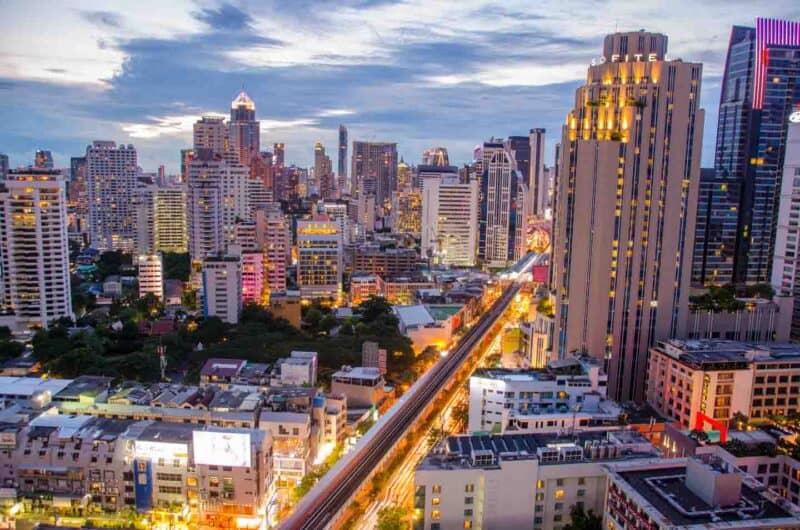
Luxury Hotels (Over $100 night): Luxury hotels in Thailand cost a fraction of the price compared to other destinations. For just over $100 a night, you can stay at the Westin in Bankok, their heavenly beds help cure jetlag. On the islands stay right on the beach with views for days.
Midrange Hotels (Under $100 night): Stay in popular hotel brands like Park Plaza, Hyatt, Mercure, Holiday Inn, Aloft, and many more right in the heart of Bangkok. For even $50 a night, you’ll be able to find a clean, comfortable, and centrally located hotel. Click here to search for hotels in Bangkok, Booking.com has the most hotels and the best prices in Thailand.
Vrbo: Vrbo is a great alternative to hotels, especially if you’re staying longer in a city or traveling as a group or as a family. You can rent crazy gorgeous villas on the islands for a fraction of the price of hotels or penthouse apartments in Bangkok.
When deciding where to stay in Bangkok make sure you understand the neighborhood the Vrbo is in so you don’t spend a lot of time getting to & from the attractions. We personally don’t suggest it in Bangkok as it can be hard finding the place and getting let in. It’s great for the islands and other cities.
Hotels/Guesthouses ($10 per night): There are tons of hostels in Thailand with dorm rooms for under $10 a night. If you’re in Bangkok, we suggest Lub’d Siam or Lub’d Silom. It’s one of the coolest hostels ever and the cleanest. It is on the “pricier” side but worth it. You don’t want the cheapest room in Bangkok.
Where to stay in Bangkok – This is probably one of the hardest to figure out and can really impact your trip to the city, so we’ve put together a Bangkok specific accommodation guide.
Things To Do In Thailand

1. Go Island Hopping – Rent a longtail boat for the day and go exploring the Thai islands. Often, you can rent a boat for the whole day for under $50. Spend your day snorkeling or on your own private beach.

2. Explore Bangkok – Most trips to Thailand start or end in Bangkok. Plan on spending 3 days in Bangkok to get a good feel for the city and see the Bangkok attractions.
We also suggest going on a food tour in Bangkok so you know early on in your trip what your favorite Thai dishes are. Bangkok is a city you either love or hate. We LOVE Bangkok.
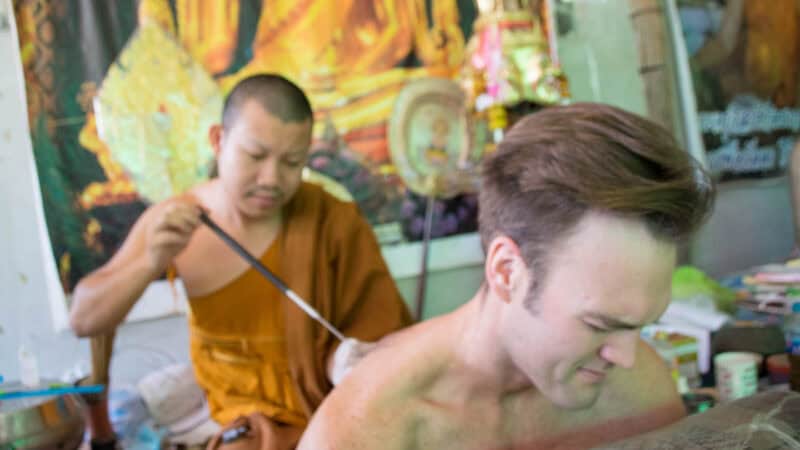
3. Get A Sak Yant Tattoo – The best souvenir from Thailand is a Sak Yant tattoo. The tattoos are done by monks with metal rods and freehand. We each have one, and they are our favorite tattoos. The tattoos are said to be magical and bless you in areas you need protection.
Related Article: Other Cool Things To Do In Chiang Mai
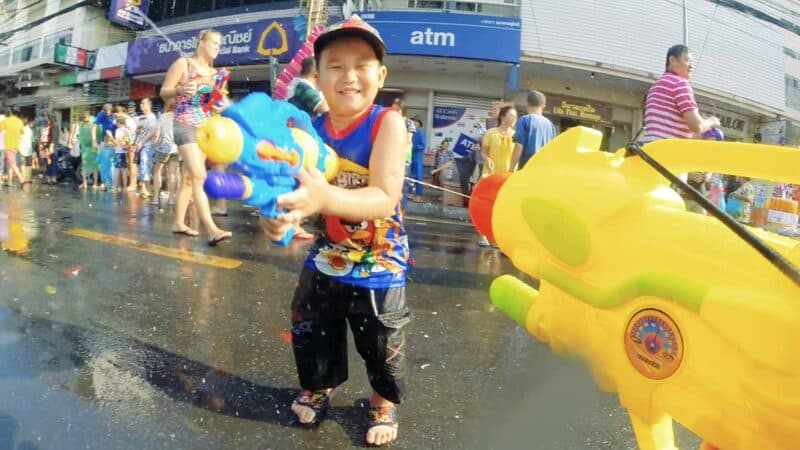
4. Celebrate Songkran Festival – Celebrate the Thai New Year with the world’s largest squirt-gun fight. Head to Songkran in Chiang Mai or Bangkok for the most epic battles.
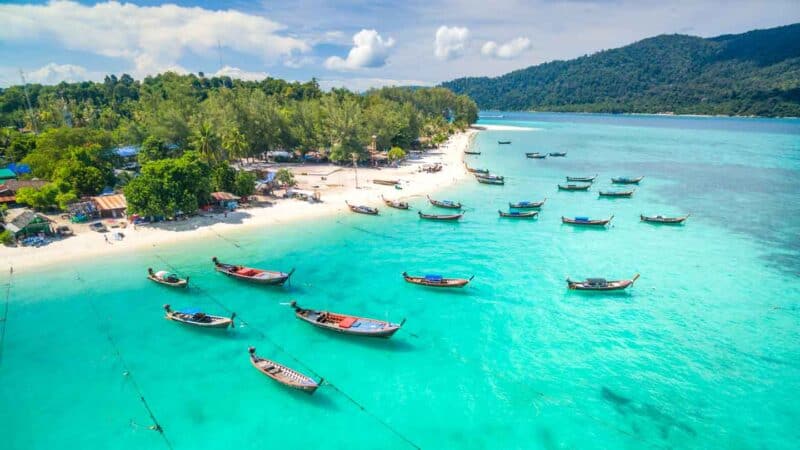
5. Relax in Koh Lipe – Do nothing but take in the view. Thailand’s prettiest island Koh Lipe is nicknamed “The Maldives of Thailand.” White sandy beaches and turquoise water like no other place in Thailand.
Most tourists head to Phuket or Phi Phi, but we always suggest the smaller, lesser-known islands.
Make sure to check out our complete list of things to do in Thailand!
What To Eat In Thailand
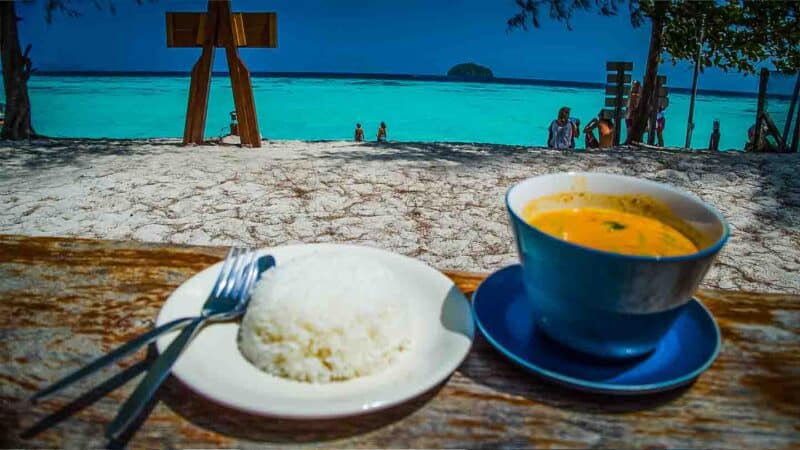
Curry: Thai Curry is served in many different flavors: red curry, green curry, yellow curry, Penang curry, and Masaman curry. The most popular and famous curry is Thai green curry with chicken.
You can typically get curry with chicken, pork, beef, or vegetarian. Typically, it is spicy, so make sure to order it not spicy if you can’t handle the Thai spice.
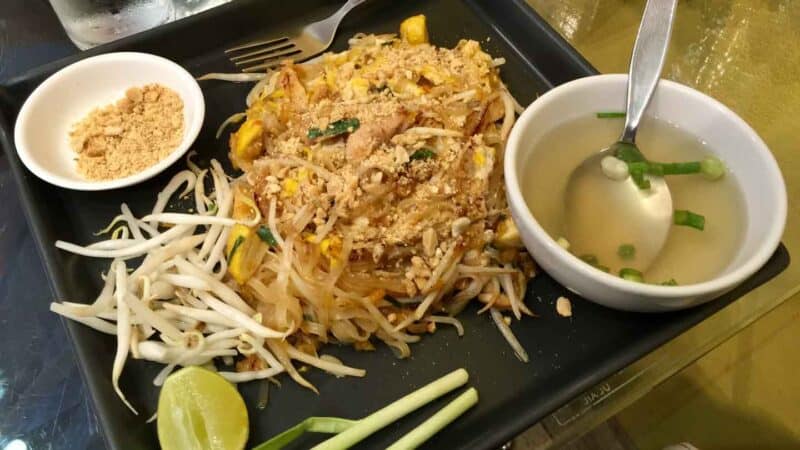
Pad Thai: Thailand’s most popular street food dish is served all over the world in Thai restaurants. Pad Thai is stir-fried rice noodles with eggs, firm tofu, green onions, dried shrimp, garlic, Thai chili peppers, and fish sauce (it sounds bad, but it’s good).
It’s often served with chicken. It’s hands down the most popular item for tourists. If you are in Bangkok, read our What to Eat in Bangkok Guide to discover the best Thai foods to try.
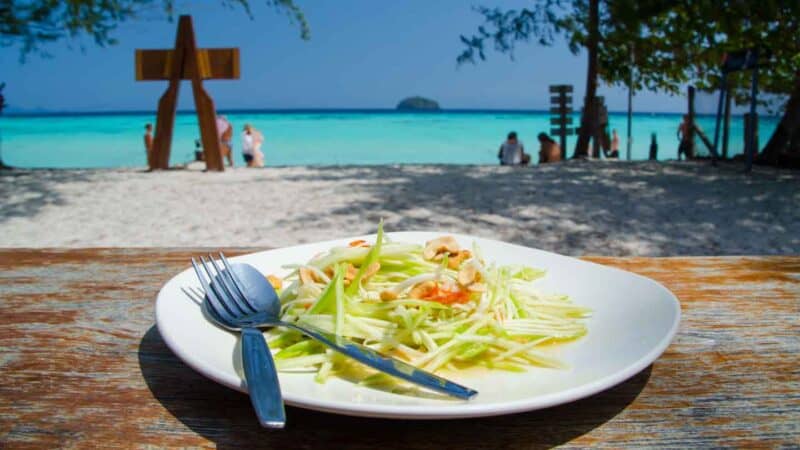
Papaya Salad: Papaya salad is nothing like it sounds like. It is not a sweet fruit salad. It’s called som tum, and “som” means sour. “Tum” is the sound made when all the ingredients are muddled together.
It’s green papaya, carrots, and fish sauce, garlic, tomatoes, chili, sugar, etc. Ingredients vary based on the vendor and what type of papaya salad you order. It’s one of our personal favorites. It’s super light and healthy. You can get it at most restaurants and street food stalls. This is served spicy tell them how many if any, chilis you want in your salad. We like two, but that is a pretty high level of spice. Proceed with caution.
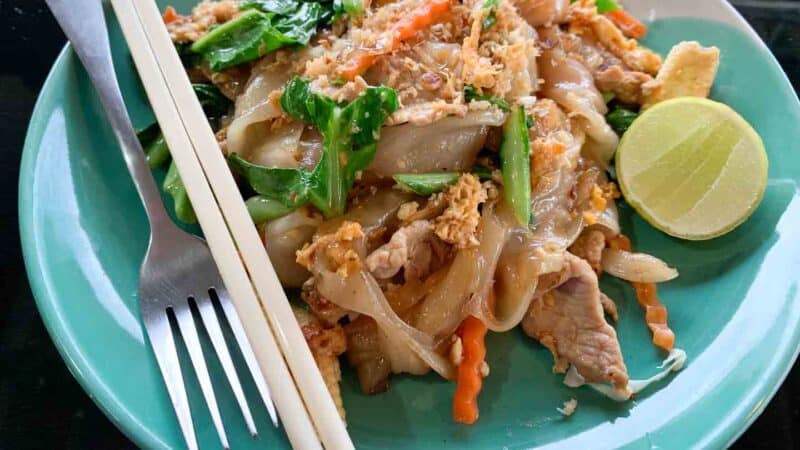
Pad See Eww: This is a Thai fried noodle dish with really fresh thick rice noodles with eggs, Chinese broccoli, soy sauce, and chicken or pork if you wish. This is typically served at restaurants and not street food stalls.
There are plenty of Western dishes available everywhere. There is no shortage of McDonald’s and Starbucks. If Thai food isn’t your thing, you can get a pizza or burger in any city, but you really need to try authentic Thai food at least a few times – even if you don’t care for it at home.
Useful Thai Phrases
In most tourist cities, you’ll find English widely spoken by most people you would interact with as a visitor. However, a few phrases will help you connect with locals and sometimes even get you a better deal while shopping in the markets or in a taxi.
Polite Closing Particles: Khap (men) and Ka (women) are added at the end of many phrases in Thai. Its use denotes manners and respect. For example, women would say Sa-wad-dee Ka, and men would say Sa-wa-dee Khap. It doesn’t matter the gender of the person you are speaking to, it only matters your gender to determine Khap/Ka.
- Hello & Goodbye: Sa-wa-dee + Khap/Ka
- Thank You: Khop Koon + Khap/Ka
- Sorry: Khor tort + Khap/Ka
- How Much: nee Tao Rai?
- Check Please: Check Bin + Khap/Ka
- Not Spicy: Mai Phet
- Spicy: Phet
- Don’t Want: Mai ow
- The number 10: Sip
- The Number 100: Neung Roy
Don’t forget your insurance! You never know when you’ll need it. We suggest getting travel insurance with Safety Wing. Which coverage includes medical, trip interruption, lost luggage, and more. Often rates are as low as $12 a week.
Explore More Thailand Articles
- Where To Stay in Bangkok
- Koh Lipe – The Maldives of Thailand
- 3 Days in Bangkok
- 2 Weeks in Thailand
- 5 Amazing Overwater Bungalows in Thailand
- Getting a Sak Yant Tattoo
- Ultimate Thailand Island Hopping Guide
- Thailand Honeymoon Guide & Itinerary
- Complete Tipping in Thailand Guide
- Koh Adang
- Street Food Survival Guide
- Eating Bugs in Thailand
Don’t Forget to Pin Me For Later!
